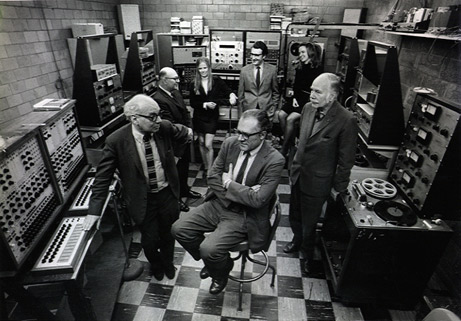In the wake of the musique concrète revolution, two technicians from RCA, Harry Olson and Herbert Belar, completed their Mark II Electronic Music Synthesizer at the Sarnoff Laboratories in Princeton, New Jersey in 1957. The electronic basis of the synthesizer was vacuum tubes which were controlled by paper tape with holes punched in it. The Rockefeller Foundation purchased it in 1959 and had it installed at the newly built Columbia-Princeton Electronic Music Center where it quickly became the centerpiece of the various composers there including Milton Babbitt, Otto Luening, Alice Shields, Mario Davidovsky, Bulent Arel, Vladimir Ussachevsky and others who wanted to get back to electronically generated sound.
The Mark II, like its Teleharmonium predecessor four decades earlier, was no small operation. It took up four rooms. Its oscillators had a tendency to drift after only a couple of seconds and were impossible to keep tuned. Consequently, conventional music could not be composed on it. The Mark II was inherently in the domain of avant-garde. The composition would be punched into paper tape with a typewriter keyboard. When the tape was run back, the Mark II would play it back. It also spit out a copy onto a vinyl disc that could be kept for reference or played elsewhere.

Ussachevsky at CPEMC adjusting the Mark II.

Milton Babbitt at the typewriter keyboard that punches the paper tape. Babbitt has never composed on any other synthesizer.
Babbitt’s “Ensembles for Synthesizer”:
Babbitt- Ensembles for Synthesizer (1/2) - YouTube

In this setting, there is little difference between a composer, a researcher or a technician. Ussachevsky stands at the right.

A good look at the keyboard and paper tape.

(Seated) Ussachevsky, clockwise around him are Babbitt, Arel, Pril Smiley, Davidovsky, Shields and Luening.

Nor was electronic music strictly the domain of eccentric, old white guys. There are a number of females whose pioneering work is legendary including Alice Shields, Pauline Oliveros, Laurie Spiegel, Pril Smiley, and Maryanne Amacher. Clara Rockmore is considered the foremost skilled performer with the theremin which she began mastering as a teen when she was already famous as a concert violinist.